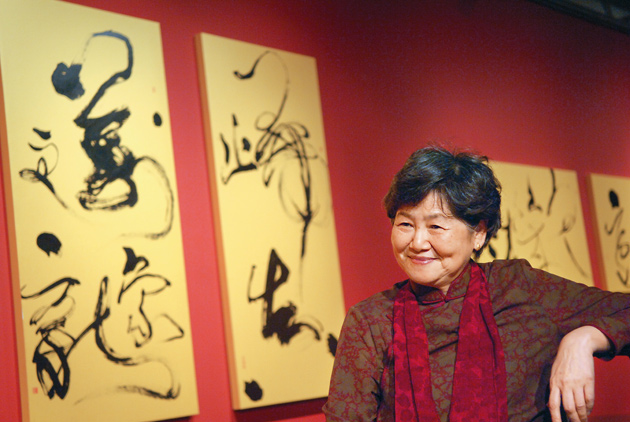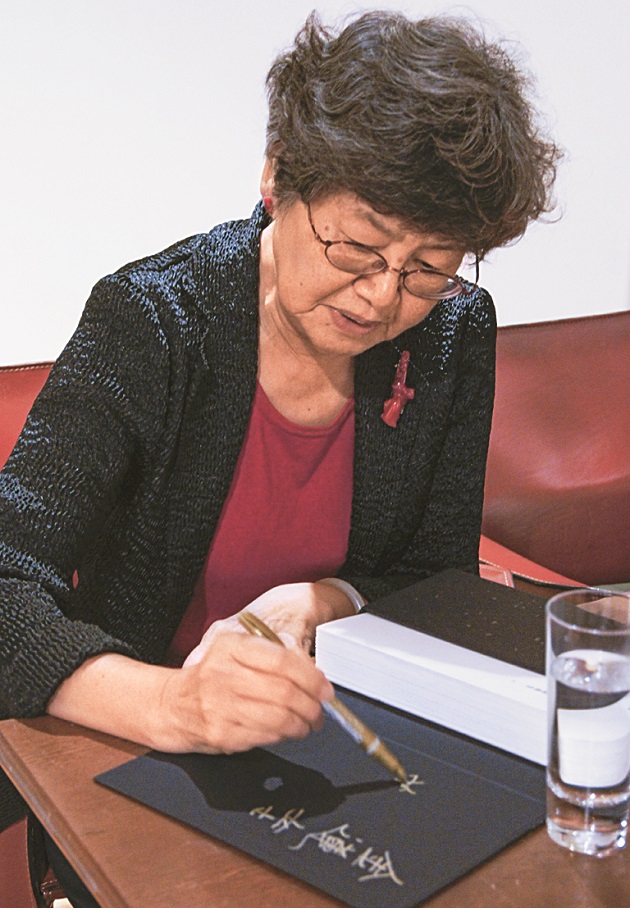Fighting for Taiwan:Tong Yang-tze
Reviving the Joy of ‘Characters’

Source:CW
Passionate about calligraphy and its charm her entire life, Tong Yang-tze has set out to help the younger generation appreciate the beauty of written characters and transform their contours into a unique Taiwanese treasure.
Views
Reviving the Joy of ‘Characters’
By Rebecca LinFrom CommonWealth Magazine (vol. 600 )
If you live in Taipei, it’s almost impossible not to come across Tong Yang-tze.
Whether in the bustling Taipei Main Station, the upscale Wellspring Theater, the popular Taipei Cultural Center City Stage or even art museums, Tong’s bold and free-flowing characters are bound to be dancing before your eyes.
‘Beautiful, Yet So Powerful’
Calligrapher Tai Ching-nung once said Tong’s characters have a kind of masculine beauty that represent “a new realm in the convergence of painting and calligraphy.” The four characters for “Cloud Gate Dance Theatre” that travel the world with the renowned dance group were drawn by Tong when she was 31. “Beautiful, yet so powerful” is how Cloud Gate founder Lin Hwai-min describes them.
Now 73, Tong remains a calligrapher but has also evolved into a “contemporary artist.” Having drawn characters her entire life, Tong decided at the age of 60 to dive into new fields and get people from other walks to “play” with these toys with her, pushing the enjoyment she derives from characters to a new high.
In 2003, she collaborated with architect Ray Chen on an exhibition titled “Emotional World” that played off a work by famed Ming Dynasty poet Yang Shen. They took 60 characters from the poem “Linjiangxian” (literally “An Immortal by the River”) starting with the line “On and on the Yangtze River rolls, racing east” and wrapped the majestically painted characters around more than 50 meters of a gallery’s wall. The characters and space echoed off of each other, displaying both the boldness and frustration of the historical heroes depicted in the verses.
In the successive productions “Sao,” “Sao+” and “Sao 2016,” Tong worked with young artists to fuse her calligraphy with the performing arts, multimedia, contemporary dance and jazz to give the calligraphic contours projected into space a new lively dimension.
“Jazz and contemporary dance are Western. Only my brush strokes were from Taiwan, and they were designed to create a commotion and draw you in, to the point where you’ll want to participate,” says Tong, who suddenly raises her right hand and points straight ahead, asking young people, “Why are you still not doing calligraphy?”
 Tong Yang-tze often says Chinese characters take on the personalities of the eras in which they are written. She is hoping to create lines representing this era.
Tong Yang-tze often says Chinese characters take on the personalities of the eras in which they are written. She is hoping to create lines representing this era.
She is constantly crossing boundaries in a never-ending pursuit of new frontiers. Her creative fusion of calligraphy with poetry, music, dance, architecture and design represents her determination to help the new generation appreciate the beauty of calligraphy and the many faces of Chinese characters and wean youngsters away from their obsession with Western culture.
In fact, every one of her exhibitions or productions reveals a different side of Tong Yang-tze. Several shows at Eslite Bookstore’s Xinyi branch in recent years, including the most recent “Confucius Said” exhibition in June 2016, prove the point.
“About 95 percent of what has been shown has been my calligraphy, but the styles of the characters were all different,” says Tong, who has always embraced challenges, tried to get the most out of every experience and insisted on not doing things that have been done before, including not replicating her own work.
Most characters have flowed along with the currents of Tong’s life, but there’re a few, such as the formal character for the number two “貳,” that took Tong many years to warm up to.
“I never used to be able to write this character, but now I can knock it out in a single go and write it really well,” Tong says as she draws the character in the air with her finger.
So why is she now finally able to write the character? “It’s just that the time had finally arrived,” she replies.
Happiness in ‘Entertaining Yourself’
Behind every one of her works, from “Find a Suitable Life” (任所適) to “Making Do” (鑄山煮海), Tong is expressing her own point of view and conversing with society.
In her mind, “Making Do” represents the Taiwan spirit, while “Entertain Yourself” (獨樂樂) represents an idea, an open attitude.
“The art of calligraphy is something that gives me pleasure on my own. I also hope others can have fun with it and appreciate the happiness of ‘entertaining themselves,’” says Tong in a raspy voice, the result of damage done to her throat when was intubated last year after falling ill.
Tong’s major when she was studying in the United States was oil painting, and because of that she puts heavy emphasis on structure and space when choosing and writing characters. When Tong draws out the seven-character title for this special edition of CommonWealth Magazine,"為台灣奮鬥的人"(meaning “the people fighting for Taiwan”), the characters flow freely and are laid out poetically, yet their relationship to each other tacitly conveys their relative emphasis.
In the seven-character construction, “the character ‘為’ is definitely softer while the characters ‘台灣’ (Taiwan) are stronger, because ‘Taiwan’ is the more important element,” she says.
Listening to Tong describe the simple composition, it’s as though she was erecting a building. “The ‘fight’ is to describe the person; you’re ultimately talking about the person,” Tong says.
In everything she has done, Tong has not only been determined to have society appreciate calligraphy and the power and modernity of Chinese characters but also to give back. Wherever she goes, she invariably says she represents Taiwan.
“I want to do something for Taiwan. It’s what I should be doing,” Tong says of her trip to Suzhou, China in March 2016 to exhibit her work there for the first time and of her trip to Belgium in May.
Tong came to Taiwan from Shanghai when she was in the fourth grade, then graduated from National Taiwan Normal University before heading to the United States for advanced studies and then returning to Taiwan to pursue her artistic endeavors.
Through it all, she has never forgotten the kindness and generosity of society. Whenever she puts on shows with artists from other fields, she not only chooses the theme but also often digs into her pockets to put up money and effort.
“I’m not like wealthy people who can donate money, but I have a brain,” she says. “I can donate my creativity and show you how it’s done, and get you to realize that characters can be a lot more fun than you ever imagined.”
Translated from the Chinese by Luke Sabatier






